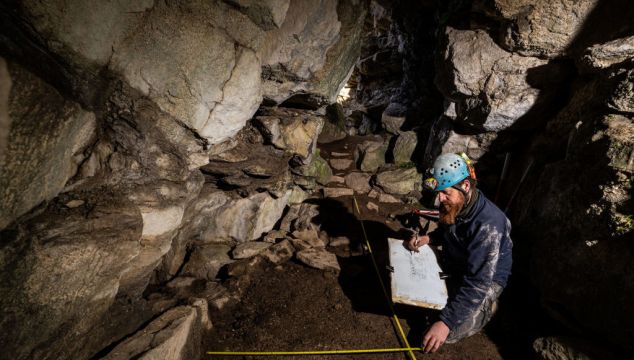A team of three archaeologists have completed the excavation of a once-lost mountain cave in Sligo used as an IRA hideout during the Irish Civil War.
34 anti-treaty IRA men survived in the small cave for six weeks during the conflict of the 1920s – with the hideout so successful that its location was later lost for a decade.
Now almost 200 artefacts have been discovered at Tormore Cave high in the Dartry Mountains overlooking Glencar Lake in north Co Sligo, during this first archaeological excavation of a Civil War site in Ireland.
“Many people knew that a mountain cave had been used as a hideout for six weeks, but almost no one knew where it was located,” said Dr Marion Dowd of Atlantic Technological University, who spent over a week excavating the cave alongside archaeologist Robert Mulraney and Dr James Bonsall.
“Because so few people have visited the cave over the past 100 years, the site was essentially a Civil War time capsule. The structures and artefacts we discovered were as they had been left when the men abandoned the cave in October 1922.”
The archaeological excavations, funded by ATU, revealed that the cave had been modified and prepared for usage, with a large boulder strategically placed at the entrance.
On either side of this, stones were piled against the cave walls and fixed with mortar. This served to conceal the cave entrance, making the hideout extremely difficult to find.
Following the Civil War, the location of Tormore Cave was lost. However, in the mid-1930s General Officer Commanding William Pilkington, one of the men who had hid there in 1922, returned to Sligo and revealed its location.
'This is not just a Sligo story'
Inside the cave where the men hid for six weeks, conditions were far from luxurious. They could not light fires as the smoke would attract attention, and had to survive with little food, cramped into the small, damp and dark space.
The excavation recovered shards of pottery and glass that related to food brought by local families to feed the men.
“Much of the pottery probably came from Sarah Branley’s kitchen,” Dr Bonsall said. “The Branleys lived a short walk from the cave and two of Sarah’s sons, Paddy and Dominick, were hiding in the cave.”
The researchers are now trying to identify other men who sought refuge in the cave, said Mr Mulraney, and are appealing for their relatives to make contact.
“So far we have identified seven men and have been speaking with their relatives,” he said.
“This is not just a Sligo story. We have had contact from people in Boston (USA), London, and counties Galway, Down and Dublin whose father, grandfather, uncle or granduncle stayed in the cave during the Civil War. We hope to hear from others,” said Dr Dowd.
If you have any information about the cave, the team can be contacted by emailing dowd.marion@itsligo.ie







